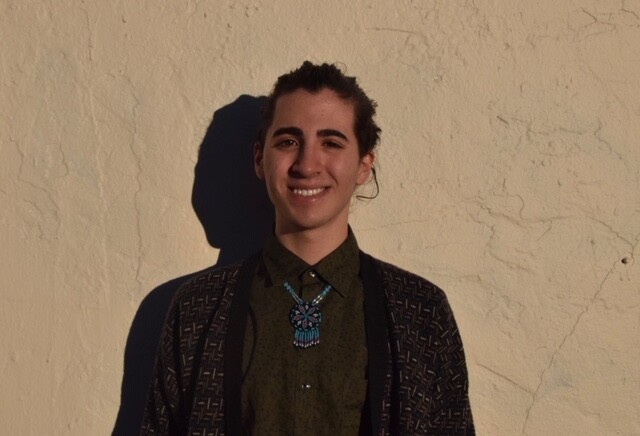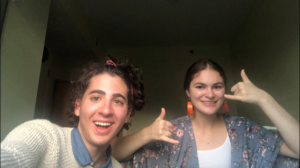
The following post was written by Global Gap Year Fellow Jacob Gerardi. Jake is spending the second half of his gap year in Dlǫ́ʼí Yázhí, a town in Navajo Nation know as Thoreau, New Mexico in English.
I realized recently that I’ve been growing my hair for roughly thirteen months, having last cut it in January of 2019 before a model UN conference in which I wished to look “clean-cut” (Eurocentric, I know). Looking at this picture of myself and my well-trimmed hair, I can’t help but feel that so much more than a year has passed. I feel older, more knowledgeable; for sure, I am wider traveled and more knowledgeable about the world as a whole, familiar with a few more of its infinite corners, cracks, and crannies. I am not sure if it’s because of my hair, or if I really have changed a good deal, but I feel that I look more mature, that I look like I’ve aged.
I began my hair-growth journey out of a desire for a closer connection to my Indigenous culture and background, a connection that has been only tenuous for much of my life due to inter-generational shame and trauma that shape my family history. It is additionally because I live far from Mi’kma’ki, the traditional homeland of my nation which I visited for the first time earlier in my gap year. By growing my hair, I was and am choosing to disregard Western and Eurocentric standards of men having short hair, and women long. While this was not the distinct precipice of my decision to grow my hair, I do enjoy challenging the gendered assumptions we as Westerners assign to hair length or style.

I know that my maternal male ancestors wore their hair long for tens of thousands of years, as is indicated by anthropological records as well as oral and written tradition among ourselves and many other Indigenous groups to this day. In growing my hair, I am tapping into this ancient tradition, embracing the role hair has in one’s development and one’s life both literally and symbolically. Having long hair is grounding; my coworkers within DigDeep, the charity I am interning within Navajo Nation, joked that having short hair makes one crazy. Whether or not this is true is up to you, but I firmly believe in the grounding power of long hair, partly due to the length of time for which one must remain devoted to hair growth in order to transition from a short haircut to much longer.
As I look into my bathroom mirror and apply the leave-in conditioner my ancestors wouldn’t have had (although their hair presumably was not curly as mine), I think back over all that has happened to me throughout the last year, and the enormous changes that I’ve experienced in my life since. Perhaps the last time I cut my hair was a good time to do so, leaving behind the weight of 13 years of public school education as well as college application season and the pain I felt while attempting to court an absurd amount of elite colleges and universities. The hair I now carry bears all of the events of my life afterwards. My senior year, and the unforgettable summer that followed. My first trip to Israel, one of my ancestral homelands, and my first trip to Mi’kma’ki (Nova Scotia), another of them. A confusing first day in Cuba, an emotion-filled last day with all those students and friends I’d come to love in La Habana, and all those days in between. I visited Finland, Norway, and Sweden bundled up by these curly locks in the brisk cold and expansive darkness of an arctic January. I now bring them with me to Navajo Nation (used as a proper noun to emphasize sovereignty), and I tie them up carefully every morning to not interrupt my work within DigDeep. I hold with myself a better souvenir than any other, a physical reminder every day of all which I’ve been through and experienced over the last year.
An important aspect of the pan-Indigenous cultural significance of hair is the question of at what point does it become appropriate to cut what is viewed as an extremity of the body rather than a dead mass of cells. Traditionally, hair was only cut in times of mourning or devastation; for men and women alike, sporting hair that had visibly been cut short was a signal of trauma. This became further poignant during the residential school era, a time when Indigenous children throughout the United States and Canada were taken from our families by government agents and sent to Indian Schools, where they were often physically, mentally, and sexually abused. The first step to this anti-Indigenous cultural torture was always receiving a Christian name and having one’s hair cut. Thus, there was a time less than a century ago when it would’ve been incredibly inflammatory if not illegal for me to exist in a global, urbanized society as an Indigenous male person with long hair. I have incredible and tremendous privilege in comparison with my even recent ancestors, not only due to my mixed background and white-coding features. As a person of mixed background including Indigeneity which I am extremely proud of, I have the ability in the modern day to grow my hair, to practice traditional beadwork and quillwork, to learn bits of Mi’kmaw and the other Indigenous languages of the occupied lands I stand upon. Hair is cut in times of grief – as it grows, therefore, it brings with it a history book of events and further pain, but also, healing. Hair grows with time, and with time comes strength.
Memories of the pain memorialized with cutting hair fade into the distance as hair continues to grow longer, and the length of hair indicates how far these events are in the past, a source of power. For me then, as my hair grows longer and longer, it will continue to remind me of what I left behind when I last cut it and what I foster as I grow it. My mindset around life and academics has changed more than ever within the last year, and I feel that I’m in an emotionally and culturally healthy place moving into University. My hair now carries more good memories than bad, and it reminds me every day to be thankful for the rich experiences I’ve had and continue to have over time. As I enter the world of academia, a traditionally white and colonized space, I bear with me not only my personal memories in my hair. I stand as a dissident to Eurocentric standards and gender norms. I carry the power and traditions of my ancestors, holding steadfast every day and looking to a future that is bright, while uncertain. Bringing my hair with me, I look to a future in which my children and their children will be proud and able to learn of their Indigenous background, pushing to eliminate colonized systems like blood quantum or forced assimilation. The future is bright, and the future is decolonized: it is Indigenous.
